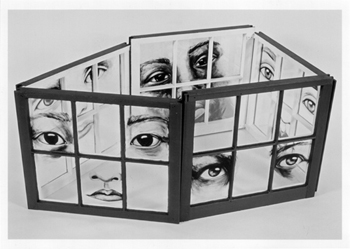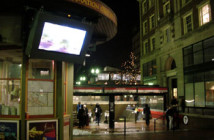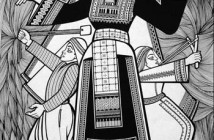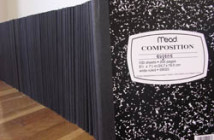Let’s say that every text, including an art exhibit, has an 'ideal reader.' This ideal reader is the subject positioned by the text’s particular modes of address. In the case of an art show, these would be the visual language of the pieces, and all attending cues like positioning, lighting, even location and hours, of the show. The ideal reader may not be quite the perfect reader who manifests all curatorial and artistic intention but is instead a feasible model of a reader. The ideal reader’s reactions and interpretations are justified in terms of the text.
My question is whether I am an ideal reader for Hidden in Plain Sight, a mildly compelling exhibit of four artists’ recent work in Brickbottom Studios’ in-house gallery. I ask because 1. I am presuming to articulate my experience of the exhibit in the form of a review and 2. my reaction was a big ho-hum, a mental “not bad, not bad.” All the trappings of an intimate, lovely show were there, yet I felt blank, registering only an entirely literal feeling of being “at an art exhibit.” And so, my thoughts on the artwork follow, ordered by favorite to least favorite.
Patty Rosenblatt, a potter, displayed massive, white, polyp-like sculptures. They are scaled-up models of the negative space of the artist’s hand, as initially captured extemporaneously in porcelain by gestural squeezes. The translation from freshly manipulated clay, to big, finished whiteness, was mysterious, satisfying, and authoritative. Two of the five total sculptures were installed outside the building in an interior courtyard. It was pouring down rain when I visited, and the surface of the outdoor pieces had been rendered luminous by the water. Rosenblatt sands, coats, and sands again the exterior of each shape, creating a finish that normally approximates untreated plaster. The change outdoors was wonderful. They gleamed luminously, as if again formed from perfect finish porcelain.
The surface effects of Peggy Badenhausen’s monoprints were pretty and the imagined architecture that guided their layout is a pleasant, lyrical conceit. However, their geometric patterning and the Badenhausen’s extensive use of dusty pastels felt distractingly dated, as if they had been made in 1988.
Alicia Dwyer’s assemblages of windows with floating eyes and feet and other G-rated body parts were catchy and boldly rendered. They seemed mostly meant to be playful pieces. Their shiny surfaces, either glass and mirrored metal, and their unmistakable surface renderings denied contemplation.
I thought Gail Martin’s paintings of her home were lame. They are lushly rendered, sequentially distorted interiors with very specific “atmospheric” effects – kind of like Eric Fischl but without the punch (and without any overt jacking off).
The works comprising the show are only very vaguely related to each other, mostly in the sense that all could be fitted into the same general conception of what art is, and what its most immediate possibilities are. Each artist employs the usual idioms of our time’s artists – oil painting, sculpture, subtle color fields, figural mixed media. Each, as the title and text for the show suggest, strives to find a visual language that is personal yet communicates effectively with an unknown viewer; what’s hidden in plain sight are thoughts and feelings that resist easy definition until the artist (the creative “seer”) takes on the task of making their insights patently visible. My problem was that most of the pieces in Hidden in Plain Sight have everything to do with the artist’s own self and felt utterly remote from mine. Is this a feasible model? I guess I am clearly not the artists’ imagined “unknown viewer.” But I did want the artwork and the show to build a better reader out of me.
Links:
Brickbottom Artists Association
"Hidden in Plain Sight" is on view until October 16 at The Brickbottom Gallery.
All images are courtesy of the Anneka Lenssen.




